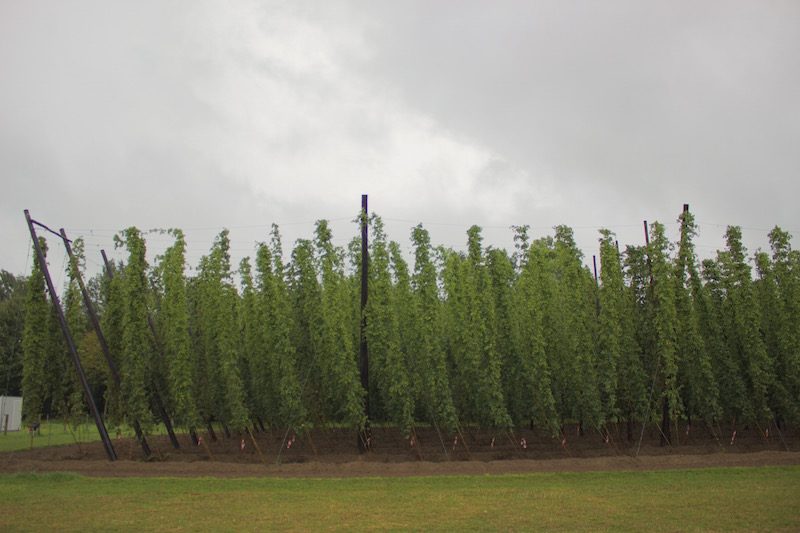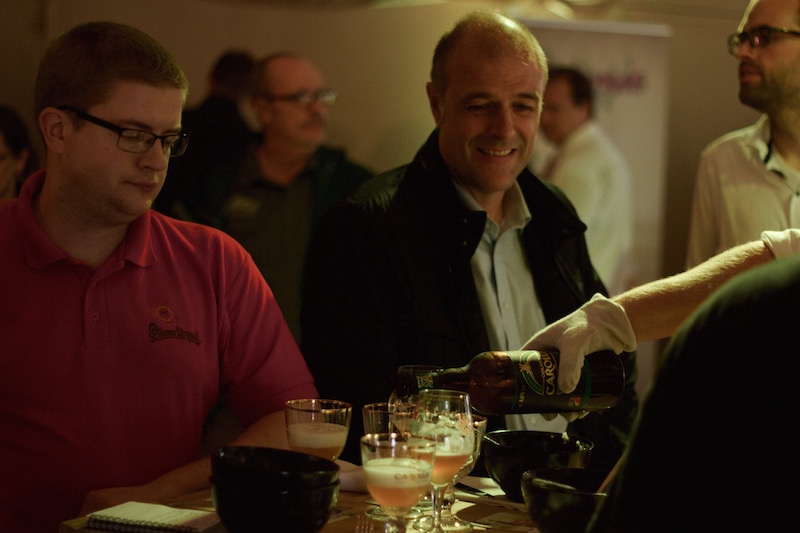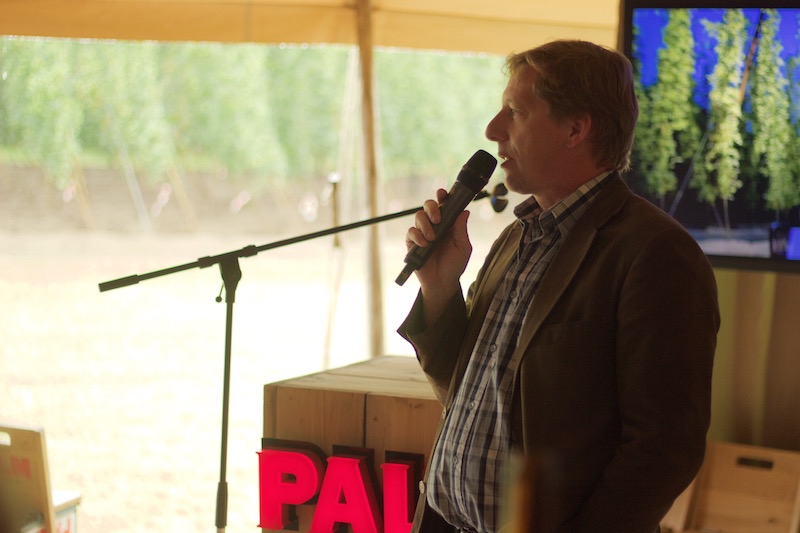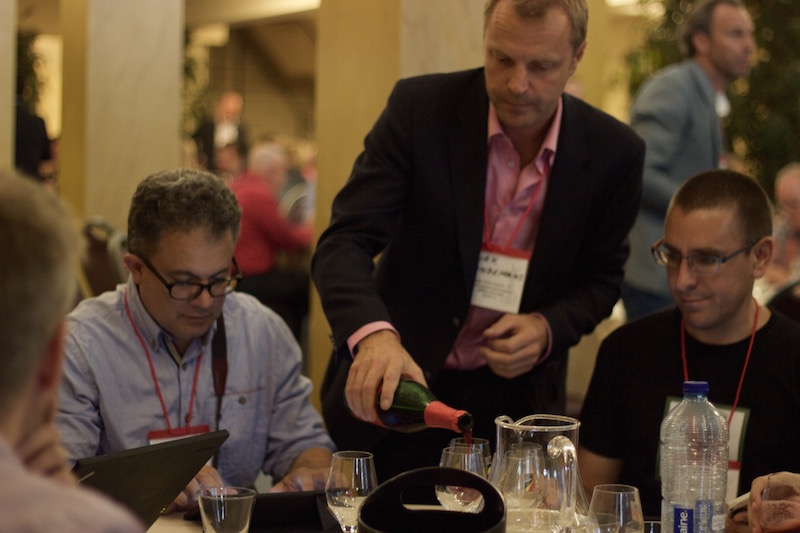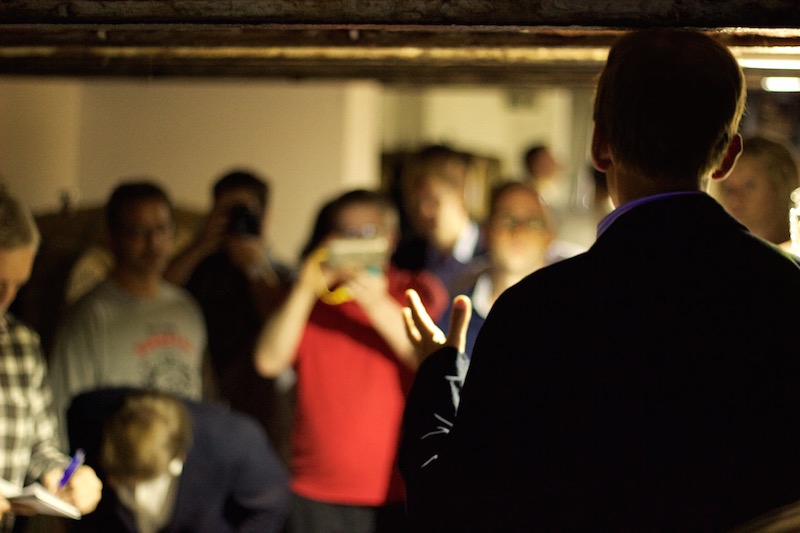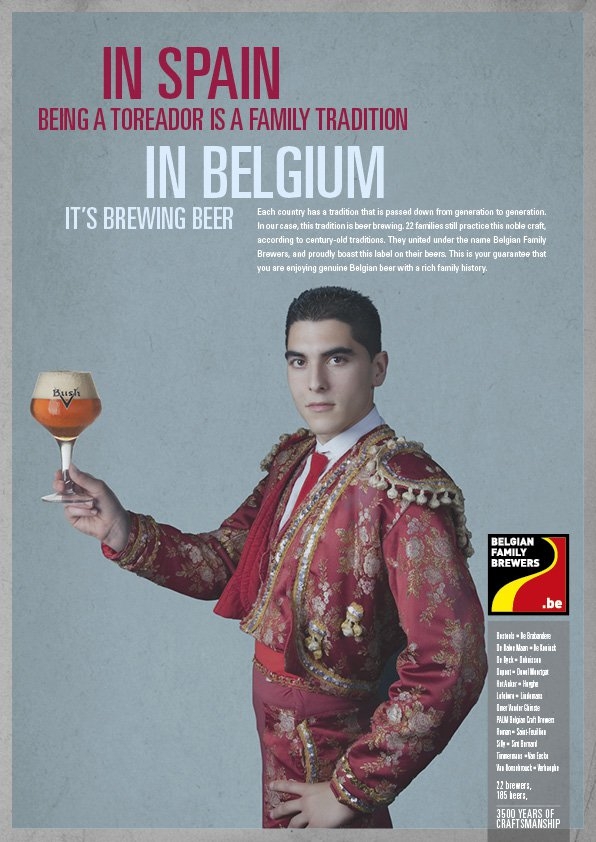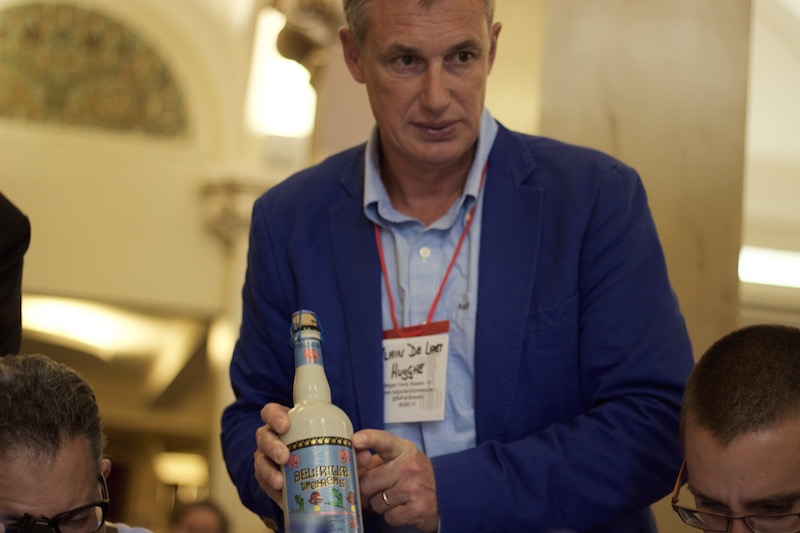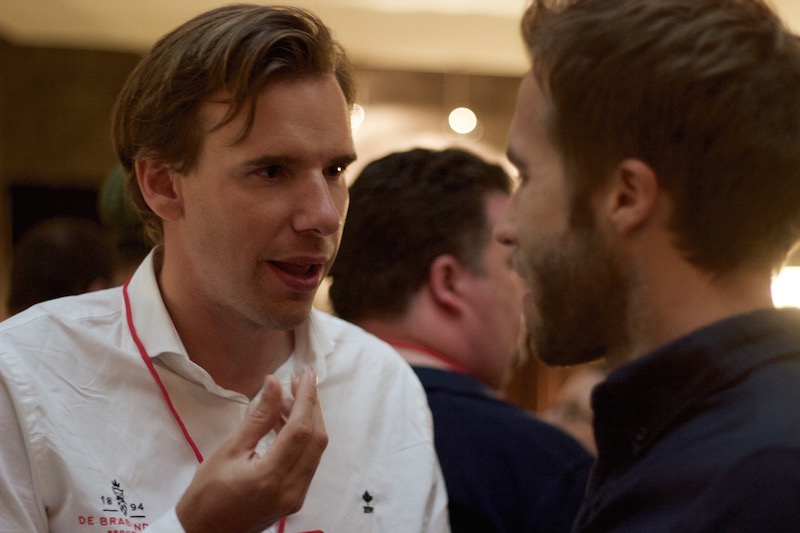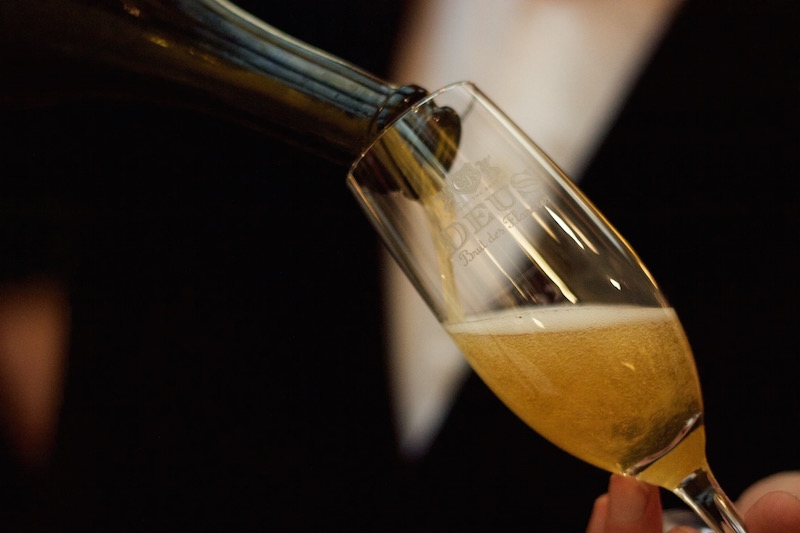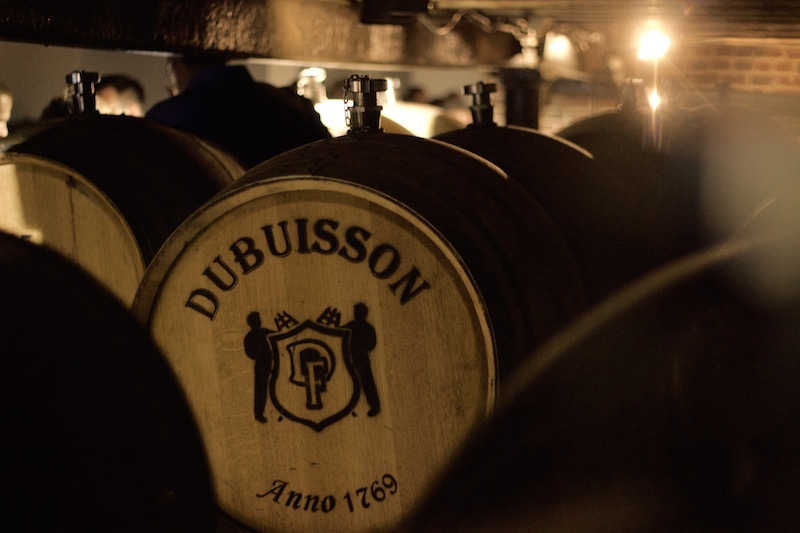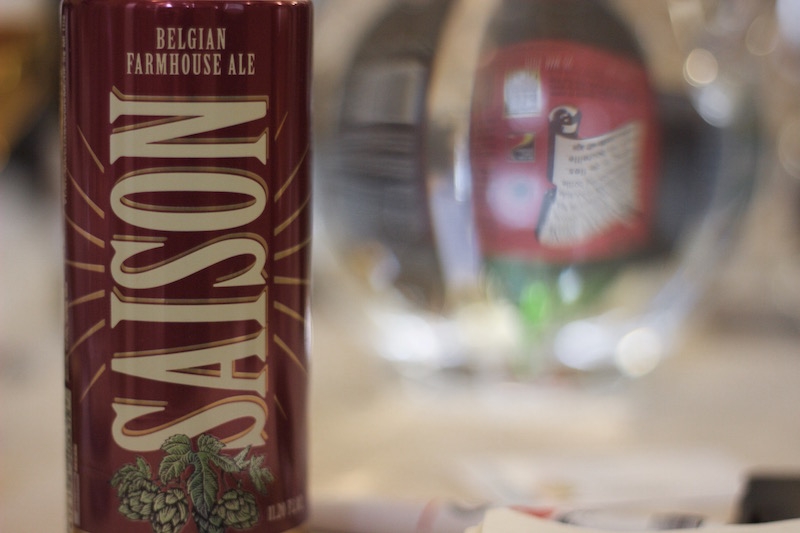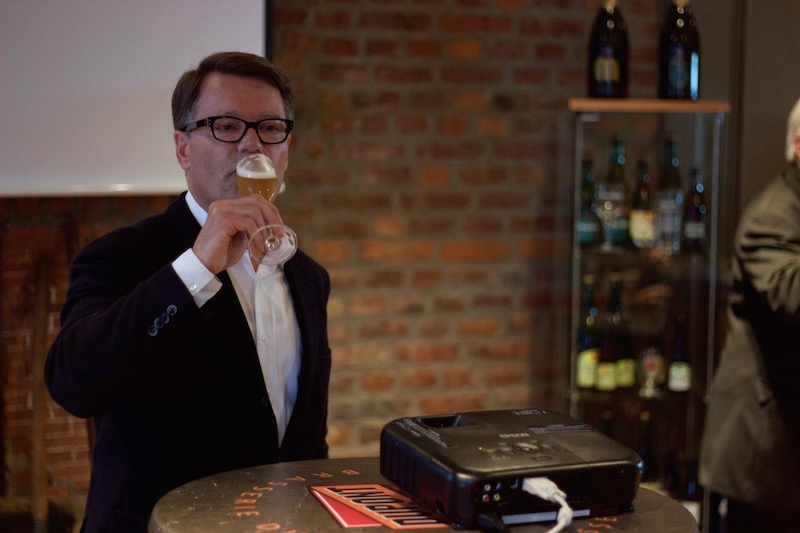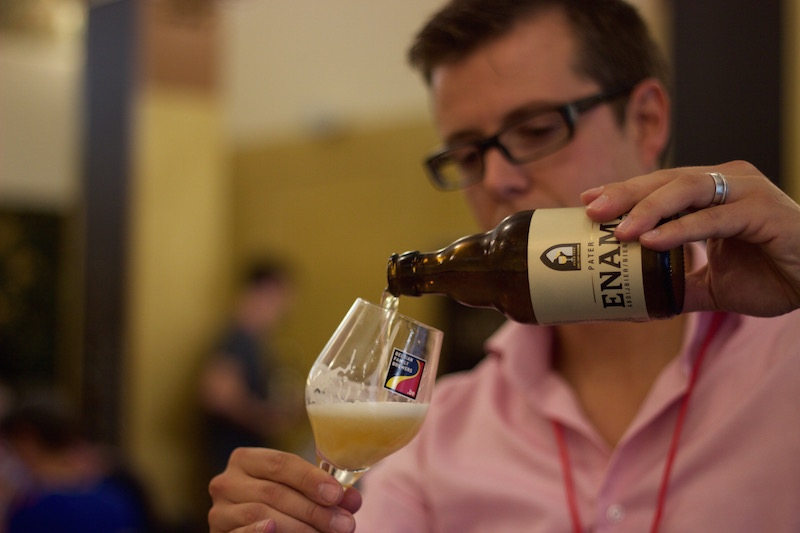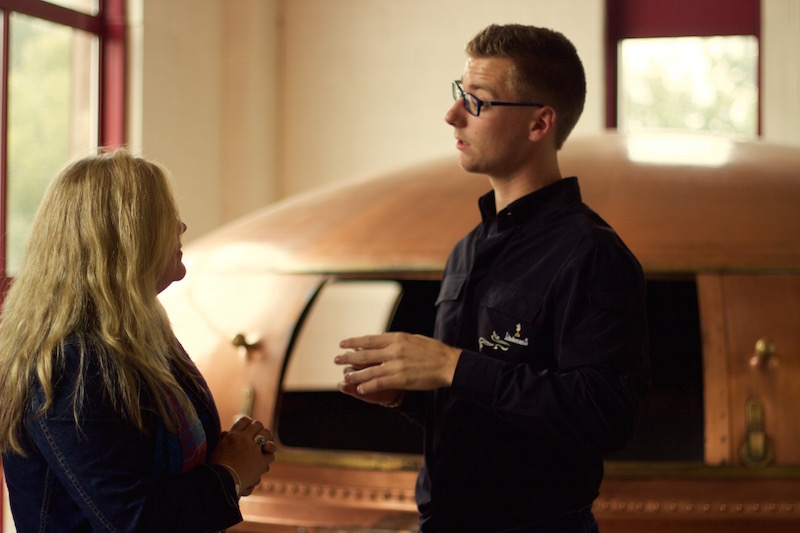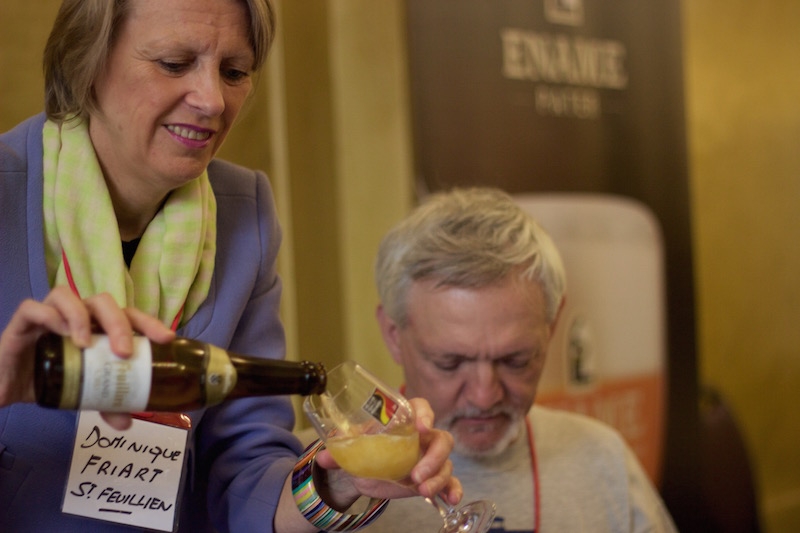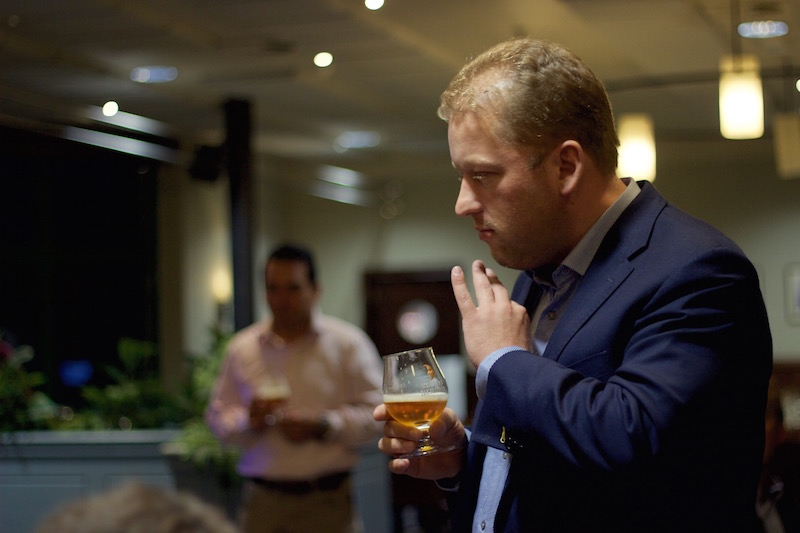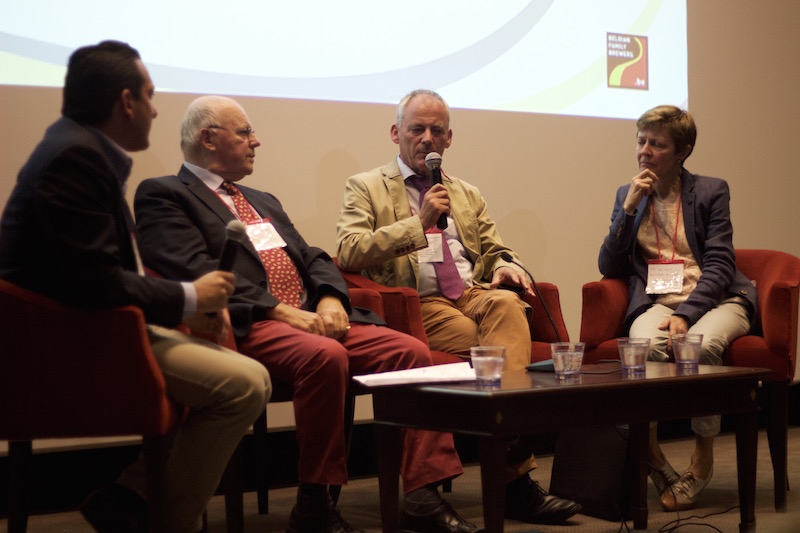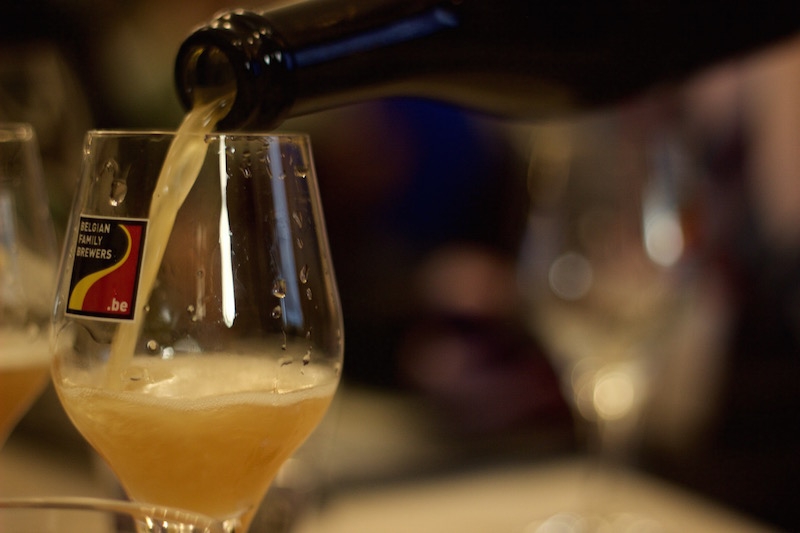A crowd of what can only be described as beer geeks assemble in a chic wooden hut at the edge of Palm’s small hop farm just outside Steenhuffel in Flemish Brabant.
It may be wet and cold in the field but it’s a warm up for the European Beer Bloggers & Writers Conference – sponsored by the Belgian Family Brewers among others – which will take place on the following few days in Brussels.
The beer geeks in question are writers, journalists and bloggers, each of whose passion for beer has prompted them to commit opinion to url or set up a channel for sharing their thoughts on youtube.
One of the beers being poured is the Gouden Carolus Hopsinjoor. “What type of hops do you use in this beer?” one of the beer geeks asks Charles Leclef who is the fifth generation of his family to own Het Anker brewery in Mechelen.
“Who cares?” Charles responds. “We prefer to talk about what it’s like to drink.”
It would be hard to come up with a more Belgian response. Part of the uniqueness of the brewing culture in Belgium has been the flippant disregard for style nomenclatures; the holistic approach to beer and its balance; the nobility of continuing the legacy of your father or mother, perhaps even with a little twist of your own.
INFLUENCE AND CHANGING LANDSCAPES
But the brewing landscape is changing in Belgium. Just look at the influence beers from the United States, Scandinavia, Italy and the United Kingdom have had on the attitudes of drinkers and brewers in Belgium. Not to mention the economic impact the maturing markets in those countries are having on Belgian exports.
The Belgian Family Brewers are dealing with that changing landscape by launching a new promotional campaign. The first teaser came at the European Beer Bloggers & Writers Conference at the end of August. That was followed up with De Langste Toog at Flanders Expo in mid-September and the subsequent packaging of the core messages of that new promotional campaign into a brand spanking new website.
BELGIAN FAMILY BREWERS
At first glance it all makes perfect sense. An association of 22 family breweries – with 3,500 years of brewing experience between them – launch a campaign which celebrates their collective values.
It’s a campaign which they hope will place the brands of their members in higher esteem than all the other bottles on the shelves. This is a genuine Belgian beer brewed in Belgium.
It’s a campaign to offer the consumer a guarantee that the beer they are buying comes from an independent family brewery that has been making beer for at least 50 years. Tradition.
And it’s a campaign to showcase beers which are original and aren’t sold under any other brand, name or label. Authenticity.
It’s not like before. It’s different this time. They’ve come out fighting. That’s illustrated by the fact that all of the breweries sent their big guns into battle at the Conference. Never before in the association’s history have all 22 ‘Master Brewers’ of the Belgian Family Brewers come together for one event.
THE NEW CAMPAIGN
So what form does this new promotional campaign take? It sets out to secure the future of the association, but in doing so it turns to the past for inspiration.
The essence is a comparison of their tradition of family brewing with the national traditions of other nations. One image reveals a Spanish Toreador standing in traditional dress holding a glass of Brasserie Dubuisson’s strong ale, Bush. “In Spain, being a Toreador is a Family Tradition,” the text reads. “In Belgium, it’s brewing beer.”
The posters continue in this vein – an Italian gondolier, a mid-western rodeo rider, a Cuban Salsa dancer, a scantily clad Brazilian Carnaval dancer – all holding beers of the Belgian Family Brewers.
But here’s the thing. Sure, these are all activities linked to their individual countries in the same way that brewing is synonymous with Belgium. And yes. They are all family traditions that have been passed down from generation to generation just as recipes and work ethic have been passed down by the family brewers.
But it seems that the national traditions they have selected are each fighting to remain relevant in their own territories. Is rodeo really the symbol of American family life in 2015? Is the controversial sport of bullfighting really a vibrant family tradition in Spain today? Does anyone outside of Venetian tourist areas really pass down the art of the gondola to their grandchildren?
TRADITION IS GOOD
Look, there’s no denying that family legacy and brewing heritage is important. In fact, it’s to be celebrated.
“My son is the reason I am here,” says Alain de Laet of Brouwerij Huyghe. “We’re just guardians for the next generation.” Keeping a brewery alive, independent and in the family for at least 50 years (most are well over 100) is no mean feat and there’s something special about the way the current BFB owners and their families before them have overcome the invasion of brewing conglomerates, world wars, changes in drinking habits and more recently the American ‘craft beer’ revolution.
But has this resilience cultivated a reluctance to change? And if so, is that a bad thing? “We don’t change the recipes,” says Didier Van der Haeghen of Brasserie de Silly. “But we do change processes and the beers become better in quality.” There’s a lot of talk of tradition married with innovation.
INDIVIDUAL BRILLIANCE AND INNOVATION
So are they ‘too’ traditional? Despite a perception of conservatism as a collective, the individual breweries in the BFB portfolio showcase plenty of diversity and innovation.
Sint Bernardus – a brewery the bulk of whose sales comes from their Abt 12 (10% ABV) – have started producing a low alcohol beer (by Belgian standards). Although Marco Passarella, Sales and Marketing Manager talks of resurrecting a ‘pater’ beer which was originally enjoyed with meals by the monks at Sint Sixtus, it’s hard not to see their Sint Bernardus Extra (which comes in at 4.8% ABV) being designed to capitalise on a trend towards more sessionable beers in Belgium.
And then there’s Brouwerij De Brabandere whose recent foray into America has inspired them to facilitate the blending of various incarnations of their foeder beer in the comfort of your own home. “The perfect blend for me might not be the perfect blend for you,” admits Marketing and Retail Manager and son of brewery owner, Albert De Brabandere. Although there’s almost certainly an element of gimmick to this, it’s a welcome step in putting some more trust into the consumer’s hands. It would never have happened 10 years ago.
The types of beers the Belgian Family Brewers are producing have also shown commendable ingenuity. Brouwerij Bosteels have taken inspiration from the wine producers of the northeast of France to produce ‘Deus’, a beer created using similar processes to those of Champagne. Brasserie Dupont – most famous for their Saison – have executed a 5% ABV dry stout (Monk’s Stout) and a 6% ABV organic smoked beer (Triomfbier).
And although Belgian breweries have been using wood for centuries in their traditional lambic and oud bruin beers, there’s been a refreshing re-engagement of barrel aging projects among the association, such as the Dubuisson Bush de Nuits (13% ABV) which spends time in oak barrels previously containing burgundy wine and the Trignac (12% ABV) from Van Honsebrouk which has been matured in cognac barrels.
Another example of this increasing innovation is in packaging. Brasserie Saint Feuillien – perhaps one of the more traditional of the BFB members – have chosen to release their Saison, a classy dry and effervescent ale, in cans (prompted by demand from the American market).
And although none of the Belgian Family Brewers are making aggressively hopped imperial IPAs, there’s no shortage of creativity with hops, evidenced first and foremost by Duvel continuing their Tripel Hop series by dry hopping this year with Equinox in addition to their bittering hops of Saaz and Styrian Goldings. The Palm Hop Select and the Fresh Harvest from Van Eecke are notable additions in this thread.
It’s not just beer, ingredients and packaging. Some of their members have demonstrated leadership in Belgium on the issue of sustainability. Brouwerij Huyghe – who produce Delirium Tremens – have invested hugely in equipment and processes and have a publically shared ambition to be the greenest brewery in Belgium. Recent visits have convinced me that they are making tremendous progress.
CHALLENGES REMAIN
Despite all of this the Belgian Family Brewers are faced with considerable challenges.
A major one relates to the question of markets and descriptors and their own attitudes as to where they should fit in.
Is ‘craft beer’ or the ‘craft beer revolution’ – labels used in pretty much every other country except Belgium – seen as a threat by the Belgian Family Brewers? “There is not one answer to that question,” says Xavier Vanneste, President of the association. “Ask the different brewers and you will get different answers.”
Many don’t share the attitude that the rising tide floats all boats and are concerned that their brands might cease to become the reference for a particular style as they have been for many years.
Even if they wanted to brand themselves as ‘craft’ (as convoluted and increasingly worthless as that term has become), it’s unlikely that other parts of the world would include them in that definition. Palm have even gone the full hog to try to make sure that they are. They rebranded themselves last year as Palm Belgian Craft Breweries.
If you asked beer lovers to name you a Belgian craft brewery, the names of Struise, Dochter Van de Korenaar and De Ranke are – rightly or wrongly – likely to surface long before those of the individual breweries of the Belgian Family Brewers.
That must be annoying for them because they espouse unquestionable qualities of craftmanship. Breweries like Verhaeghe clearly care about their ingredients, the flavours and aromas of their beers and the places they have come from.
But perhaps it’s the attitude associated with the ‘craft beer movement’ – admittedly itself being subjected to an existential dissection – that is missing among the Belgian Family Brewers.
COLLABORATION
Take the concept of collaboration, for example. Despite it being listed as one of the Belgian Family Brewers’ core values, it seems to sit uncomfortably with the individual brewery owners.
Dominique Friart of Brasserie Saint Feuillien – who last year brewed West Coast IPA for San Diego’s Green Flash Brewing – admitted that although she enjoyed the experience, she would never do it again.
When asked if the Belgian Family Brewers would ever consider doing a huge collaboration brew, perhaps something in the vein of the HORAL Oude Geuze Mega Blend, the instantaneous answer from Xavier Vanneste was “No”.
“You should,” came the response from participants at the Conference.
“We won’t do collaboration brews,” said Xavier, clarifying. “That’s not the aim here. We don’t purchase together. We don’t distribute together. We don’t sell together. The idea is that every brewery is independent.”
Whether as a marketing gimmick or a community builder, there’s plenty of evidence that there would be an appetite among beer lovers for something along the lines of a giant super ninja family brew, even if just to witness the process.
COMMUNICATION AND CREATION
Another example of this type of attitude relates to communication with consumers. Several of the Belgian Family Brewers are completely absent from the conversations about their beers taking place online, either because they don’t understand the platforms or they just don’t place any value on social media and online community.
And then there’s their conservatism when it comes to creating new beers. “American consumers want to experience a lot,” says Marc Lemay of Brasserie Dubuisson. “It’s important for U.S. breweries to innovate a lot because they’re responding to that local market. But in Belgium, the market is very different, very conservative and it’s almost impossible to launch a new beer.”
It’s understandable that they’re keen not to damage their long established brands by releasing beers that haven’t been thought out. But by their own admission, they all spend between 12 and 14 months developing each new beer, if any. “It’s easy to make beer,” says Willem Van Herreweghen of Timmermans. “But it’s difficult to make what the market wants.”
Contrast this approach to that of the vibrant brewing community outside of the Belgian Family Brewers umbrella in Brussels alone.
Brasserie de la Senne regularly release seasonal beers such as ‘Saison Du Meyboom’ and ‘Brussels Calling’ as well as experimental series such as ‘Wadesda’ and collaboration brews like ‘Manneken Penn’ or ‘Meurisenne’. The Brussels Beer Project – with their new 10 hectolitre brew installation – intend to create no fewer than 20 one-off beers each year. Cantillon engage cities around the world each year with their Zwanze Day project and lead transatlantic collaborations such as the Wild Friendship Blend with Allagash and Russian River.
All of these things contribute to a sense that there are other ways – perhaps better ways – for the Belgian Family Brewers to do things in this changing market; that inclusivity might benefit them more than exclusivity; and that other breweries are worth listening to, whether that’s a brilliant home brewer gone professional or an older brewery with no family brewing history.
LANDSCAPES ON THE HORIZON
So what’s going to happen? Together the Belgian Family Brewers make up only 15% of all Belgian breweries and it’s clear that they must speak to the consumer of 2015 if they are to secure their future.
Are they too conservative, too exclusive or perhaps too defensive to thrive in the coming years? Or will claiming the concept of authenticity as their own and using their long and beautiful family brewing heritage serve to strengthen and perhaps save their brands forever?
Time will tell. But one thing is for certain. The brewing landscape in Belgium is changing.
If they can look outwards and embrace those challenges with confidence in their own ability, they have an incredible opportunity on their hands.
It’s up to them to take it.


